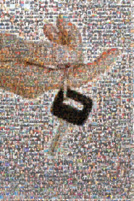sierraclub.org - sierra magazine - july/august 2009 - bulletin


Bulletin | News for Members
Wild Bill | Our New Directors | The Key to Clean Cars | Grassroots
By Melissa Weiss
The most valuable things in this life are those things that we already possess," President Barack Obama said in March upon signing the Omnibus Public Land Management Act, the largest nationwide wilderness bill since 1994. The measure preserves more than 2 million acres of previously unprotected backcountry as wilderness, the highest form of land protection on the books. It also codifies and adds permanence to the 26-million-acre National Landscape Conservation System, safeguards hundreds of miles of rivers, expands wilderness trails, and prevents oil and gas development on more than 1 million acres.
"This is a historic day for conservation," said Sierra Club public lands program director Athan Manuel.
"We've been working on this since 1980," said Edwina Allen, chair of Idaho's Northern Rockies Chapter. "We began by leading outings, giving slide shows, doing door-to-door leafleting...It's a very proud moment."
Sierra Club wilderness campaigns coordinator Myke Bybee agreed: "We'll be able to look back years from now and tell our grandchildren, 'I had a hand in protecting this special place.'"
For all the land the act protects, however, some environmentalists have complained that it doesn't include enough. In West Virginia, it created the first permanent wilderness in the Greenbrier River watershed but failed to incorporate the Seneca Creek Backcountry. "The omission was hard to accept," said Mary Wimmer, chair of the state chapter's Wilderness Planning Committee.
Utah Chapter chair Wayne Hoskisson shared Wimmer's mixed feelings. The act designated 125,000 acres of federal land as wilderness in Utah's Washington County but failed to extend the designation to the county's Mojave Desert area. "Some really important legislation came out of it, but a lot of potential wilderness was ignored," Hoskisson said.
ON THE WEB For information on land conservation issues, see sierraclub.org/habitat.
Our New Directors
 Sierra Club members elected two incumbents and chose three new representatives to serve on the 15-person, volunteer board of directors, which sets conservation priorities and oversees staff and volunteer activities. Each year five seats are up for election. Here are the winners for 2009:
Sierra Club members elected two incumbents and chose three new representatives to serve on the 15-person, volunteer board of directors, which sets conservation priorities and oversees staff and volunteer activities. Each year five seats are up for election. Here are the winners for 2009:
Kentucky resident Lane Boldman has been involved in Club programs since 1992 and received a 2008 Susan E. Miller Award for her administrative contributions (38,268 votes).
David Scott, from Ohio, has been a poverty lawyer for 20 years and is coordinating the Club's outreach efforts to the Obama administration (34,335 votes).
Current board vice president Robin Mann, of Pennsylvania, is a longtime activist for water and wetlands issues (31,277 votes).
Chris Warshaw has been a consultant for the EPA and the U.S. Fish and Wildlife Service and is a Ph.D. student in political science at Stanford University (29,516 votes).
Rafael Reyes, from California, has served on the board of directors since 2006, working on the Cool Cities and Climate Crossroads programs (28,160 votes).
To recommend a candidate for the 2010 board election, e-mail Marvin Baker, Nominating Committee chair, at MarvinBaker@msn.com.
ON THE WEB Learn more about the Sierra Club Board of Directors at sierraclub.org/bod.
The Key to Clean Cars
 The picture below represents an impersonal federal agency holding the key to clean cars. But zoom in and you'll see hundreds of snapshots of people--from a somber-faced toddler sitting in a cardboard convertible to a bearded man sporting a parrot on his shoulder--with keys in their hands and change on their minds.
The picture below represents an impersonal federal agency holding the key to clean cars. But zoom in and you'll see hundreds of snapshots of people--from a somber-faced toddler sitting in a cardboard convertible to a bearded man sporting a parrot on his shoulder--with keys in their hands and change on their minds.
More than 1,100 citizens nationwide contributed pictures to the Sierra Club's online photo petition to show the Environmental Protection Agency the face of a country that cares about clean cars. The Club compiled the images into two photo mosaics, which were presented at the EPA hearing to reconsider California's Clean Air Act waiver.
"They were only holding one public hearing, in Arlington, Virginia, in a not-so-convenient location," said Ann Mesnikoff, director of the Sierra Club's Green Transportation Campaign. "Only so many Club members could haul out there to weigh in on an issue of national importance."
Instead, concerned citizens snapped photos of themselves raising car keys in support of a waiver that would allow California and 14 other states to enforce tougher air pollution standards on cars, including regulating greenhouse-gas emissions. --Jordana Fyne
Grassroots
Puerto Rico: A Very Slow Parade
 As the world's largest turtles returned to nest on the beaches of Puerto Rico's threatened Northeast Ecological Corridor, the island's smallest humans marked the occasion with a parade. "[The children] dress up as turtles and participate in the welcoming parade," says Camilla Feibelman of the Sierra Club's Puerto Rico Chapter, which hosted the fourth-annual Leatherback Turtle Festival in the town of Luquillo on April 18.
As the world's largest turtles returned to nest on the beaches of Puerto Rico's threatened Northeast Ecological Corridor, the island's smallest humans marked the occasion with a parade. "[The children] dress up as turtles and participate in the welcoming parade," says Camilla Feibelman of the Sierra Club's Puerto Rico Chapter, which hosted the fourth-annual Leatherback Turtle Festival in the town of Luquillo on April 18.
Musicians, dancers, 65 local businesses, and 20 nonprofits participated in the awareness-raising event. "It's not just enough to protect the turtles," says Feibelman. "You also have to protect the beaches where they nest." The critically endangered leatherback turtle nests in the 3,200-acre corridor, which is being eyed by developers despite its designation as a nature reserve. The festival's organizers have better plans for Luquillo: a sustainable future as an environmental destination. "We're saying, let's protect the environment, let's stimulate the economy," says Feibelman, "and let's do it through ecotourism." --Della Watson
ON THE WEB Speak up for leatherback sea turtles: Urge the governor of Puerto Rico, the secretary of the U.S. Department of the Interior, and the administrator of the National Oceanic and Atmospheric Administration to protect sea turtle habitat.
Hawaii: Bon Voyage
The Maui Group of the Sierra Club's Hawaii Chapter won a legal battle in March that pitted environmental review against the largest corporate-backed ferry to chug through Hawaiian waters. An appeal from the chapter and other local groups led the state supreme court to unanimously overturn special legislation passed in 2007 allowing the Hawaii Superferry to shuttle vehicles and passengers before an environmental impact statement was complete. The subsequent EIS revealed the ferry ran a high risk of importing invasive species. The 350-foot Alakai, which sped between Maui and Oahu at 40 miles per hour, also threatened the local humpback whale population. Amid rumors of a military buyout, the $85 million vessel is now docked while owners discuss where to send it. --J.F.
Texas: Highway Robbery
If the Federal Highway Administration has its way in Texas's Harris County, an expansion to the Grand Parkway will destroy 700 acres of Katy Prairie, an important migratory-bird habitat that has long protected Houston's bustling cityscape from seasonal floods. In March, the Sierra Club filed a lawsuit against the federal agency for failing to complete an adequate assessment of the road project's environmental impact. Real estate developers rushed the project without considering other transportation options, such as commuter rail, that would reduce congestion, explained Brandt Mannchen, air quality chair of the Club's Lone Star Chapter. "This is not a transportation project. It's a development project, and the Houston chapter thought it was time to stand up." --Melissa Weiss
Illustration: iStockphoto/GeorgePeters; bottom photo: Jose A. Menendez; used with permission